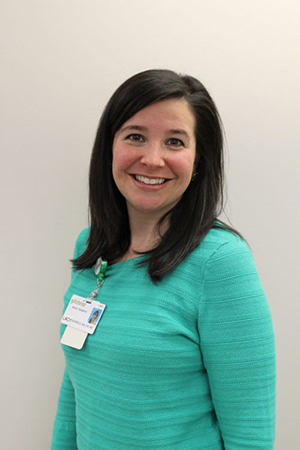She Sings to People to Make Them Feel Better

The last time I blogged about music therapy was shortly after the program at Gilchrist began in the fall of 2012. Rereading that reflection has inspired me to share some thoughts since starting the music therapy program six years ago.
When I first arrived at Gilchrist, my practice was met with an array of reactions, including excitement and relief, and at times, hesitation and judgment. These reactions were not unfamiliar and not unlike how patients and families view music therapy when they hear about or witness it for the first time.
Unlike our healthcare counterparts, we are not yet mainstream and still have a lot of explaining to do when met by someone who notices the guitar on our backs or the keyboard we carry, and the badge stating MT-BC (Music Therapist Board Certified). And yes, we still advocate that we are not just “the entertainment.”
Excitement
Excitement may not be a feeling you would associate with hospice care. But as the music therapy profession has gained more attention over the years for its benefits and become more acceptable as a modality for treatment, it is common for us to hear, “They are so excited for your visit!” Being a part of the care that a patient looks forward to—that often results in immediate pleasure and joy—is a rewarding aspect of our work.
Relief
For patients who enjoyed music throughout their life (whether through formal lessons as a child, attending a Saturday evening dance, singing in the church choir, playing in a band or attending concerts), music therapy can offer a sense of familiarity associated with life events driven by music. We hear so often, “Music is the only thing they still respond to.” When a family learns that Gilchrist offers music therapy, it often provides relief that their loved one can still find meaning in and a connection to something they have always loved.
Hesitation
We are almost always met with a certain amount of skepticism when we show up, instrument in hand, at the front door or bedside. It is not uncommon to hear, “Well, you can give it a try, but don’t expect much.” As a music therapist, I meet this challenge with compassion and understanding because I know that music can often “unlock” barriers, even for the patient who seems “too far gone.” When that barrier is taken down by a melody, a glimmer of the person who once was shines through, and we hear, “I got my loved one back today.”
Judgment
Unless you have witnessed a music therapy session—with the patient and therapist engaging, the music flowing, the memories resurfacing, the pain fading—you may think of our work as “nice” or “sweet,” with little understanding of what takes place. Over the years I’ve heard things like, “We don’t need music therapy because we have a CD player” or “Do you actually get paid to do this?” or “I want to hear what kind of a musician you are.” With the popularity that music in healthcare has gained over the past few years, the music therapy profession continually finds itself having to explain the benefits of live versus recorded music, the education of a music therapist (which takes years) and the specialized training that allows us to use music as therapy. We are therapists; music is our modality.
So what has changed in six years? Everything.
I find now that patients and families advocate for receiving music therapy because they have researched its benefits or know someone who has had the service. And with the program at Gilchrist growing, it is not uncommon for us to have treated multiple members in one family.
Before when I would walk down the hallway of one of our partner facilities, I usually garnered strange looks and would have to explain what I was there to do. Now when staff see me approach, they immediately prepare the way and state, “It’s time for music therapy!”
We no longer receive referrals because someone “likes music” (although this doesn’t hurt). Our staff understand that music therapy is driven by symptoms and needs. And while we work alongside conventional treatments, it is not uncommon to hear, “Music is the only thing that takes the pain away.”
When I am asked, “How long have you been doing this?” sometimes I can’t believe my answer: 13 years. I once overheard my young nephew explain to someone what I do, saying, “She sings to people to make them feel better.” Over the years, I have had to educate many different types of audiences on what music therapists do. And really, my answer hasn’t changed much. I provide comfort and support, foster joy and hope, bring about change and encourage strengths. Very simply, “I use music to help people.”
To learn more about the Gilchrist music therapy program, please visit our website.


